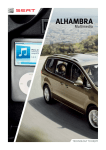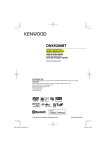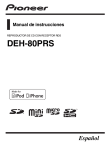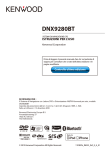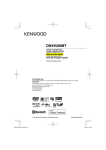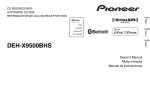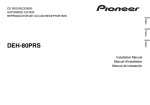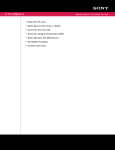Download Pioneer® Single DIN In-Dash CD/MP3/WMA/AM/FM
Transcript
CD RDS RECEIVER AUTORADIO CD RDS REPRODUCTOR DE CD CON RECEPTOR RDS DEH-80PRS Installation Manual Manuel d’installation Manual de instalación Section Connections Connections WARNING ! Use speakers over 50 W (output value) and between 4 W to 8 W (impedance value). Do not use 1 W to 3 W speakers for this unit. ! The black cable is ground. When installing this unit or power amp (sold separately), make sure to connect the ground wire first. Ensure that the ground wire is properly connected to metal parts of the car’s body. The ground wire of the power amp and the one of this unit or any other device must be connected to the car separately with different screws. If the screw for the ground wire loosens or falls out, it could result in fire, generation of smoke or malfunction. Ground wire Other devices (Another electronic device in the car) POWER AMP Metal parts of car’s body F O N OF Important ! When installing this unit in a vehicle without an ACC (accessory) position on the ignition switch, failure to connect the red cable to the terminal that detects operation of the ignition key may result in battery drain. ACC position STAR T 01 No ACC position ! Use this unit with a 12-volt battery and negative grounding only. Failure to do so may result in a fire or malfunction. ! To prevent a short-circuit, overheating or malfunction, be sure to follow the directions below. — Disconnect the negative terminal of the battery before installation. — Secure the wiring with cable clamps or adhesive tape. Wrap adhesive tape around wiring that comes into contact with metal parts to protect the wiring. — Place all cables away from moving parts, such as the shift lever and seat rails. — Place all cables away from hot places, such as near the heater outlet. — Do not connect the yellow cable to the battery by passing it through the hole to the engine compartment. — Cover any disconnected cable connectors with insulating tape. — Do not shorten any cables. — Never cut the insulation of the power cable of this unit in order to share the power with other devices. The current capacity of the cable is limited. — Use a fuse of the rating prescribed. — Never wire the negative speaker cable directly to ground. — Never band together negative cables of multiple speakers. ! When this unit is on, control signals are sent through the blue/white cable. Connect this cable to the system remote control of an external power amp or the vehicle’s auto-antenna relay control terminal (max. 300 mA 12 V DC). If the vehicle is equipped with a glass antenna, connect it to the antenna booster power supply terminal. ! Never connect the blue/white cable to the power terminal of an external power amp. Also, never connect it to the power terminal of the auto antenna. Doing so may result in battery drain or a malfunction. This unit Power cord 9 3 4 56 a b 4 2 1 d 1 L 78 c 1 USB port 1 2 USB port 2 3 Antenna input 15 cm (5-7/8 in.) 4 Audio input 5 Fuse (10 A) 6 Power cord input 7 Wired remote input Hard-wired remote control adaptor can be connected (sold separately). 8 Microphone input 9 Microphone 4 m (13 ft. 1 in.) a Rear output or high range output b Front output or middle range output c Subwoofer output or low range output d USB cable 1.5 m (4 ft. 11 in.) ! If connecting both USB1 (USB storage device1)/iPod1 (iPod connected using USB input1) and USB2 (USB storage device2)/iPod2 (iPod connected using USB input2) at the same time, use a Pioneer USB cable (CD-U50E) in addition to the regular Pioneer USB cable. R 2 3 F/M 5 R/H 6 7 8 9 a b c d e f g h i 1 2 3 4 5 6 7 8 9 a b c d e f g h i To power cord input Left Right Front speaker or middle range speaker Rear speaker or high range speaker White White/black Gray Gray/black Green Green/black Violet Violet/black Black (chassis ground) Connect to a clean, paint-free metal location. Yellow Connect to the constant 12 V supply terminal. Red Connect to terminal controlled by ignition switch (12 V DC). Blue/white Connect to system control terminal of the power amp or auto-antenna relay control terminal (max. 300 mA 12 V DC). Orange/white Connect to lighting switch terminal. Section Connections Power amp (sold separately) Standard mode with internal amp Important ! Change the DSP switch to standard mode (STD). For more details on change settings, refer to the operation manual or Switching the DSP setting mode on this page. ! The following signals are output from the speaker leads when this connection is in use. White: Front left + White/black: Front left * Gray: Front right + Gray/black: Front right * Green: Rear left + Green/black: Rear left * Violet: Rear right + Violet/black: Rear right * 3 1 2 5 01 Connections 4 5 1 System remote control Connect to Blue/white cable. 2 Power amp (sold separately) 3 Connect with RCA cable (sold separately) 4 To subwoofer output 5 Subwoofer Standard mode without internal amp Important ! Change the DSP switch to standard mode (STD). For more details on change settings, refer to the operation manual or Switching the DSP setting mode on this page. ! If using this system, we recommend that this unit’s internal amp is turned off. For details, refer to the operation manual. ! The speaker leads are not used when this connection is in use. 3 1 2 5 5 7 3 1 9 2 2 5 8 9 1 System remote control Connect to Blue/white cable. 2 Power amp (sold separately) 3 Connect with RCA cable (sold separately) 4 To Rear output 5 Rear speaker 6 To Front output 7 Front speaker 8 To subwoofer output 9 Subwoofer 3-way network mode with internal amp Important ! Change the DSP switch to 3-way network mode (NW). For more details on change settings, refer to the operation manual or Switching the DSP setting mode on this page. ! The following signals are output from the speaker leads when this connection is in use. 5 7 4 5 3 2 1 6 7 3 2 6 3 1 3 1 3 2 1 7 4 White: Middle range left + White/black: Middle range left * Gray: Middle range right + Gray/black: Middle range right * Green: High range left + Green/black: High range left * Violet: High range right + Violet/black: High range right * 4 5 1 System remote control Connect to Blue/white cable. 2 Power amp (sold separately) 3 Connect with RCA cable (sold separately) 4 To low range output 5 Low range speaker 3-way network mode without internal amp Important ! Change the DSP switch to 3-way network mode (NW). For more details on change settings, refer to the operation manual or Switching the DSP setting mode on this page. ! If using this system, we recommend that this unit’s internal amp is turned off. For details, refer to the operation manual. ! The speaker leads are not used when this connection is in use. 1 9 2 8 9 1 System remote control Connect to Blue/white cable. 2 Power amp (sold separately) 3 Connect with RCA cable (sold separately) 4 To high range output 5 High range speaker 6 To middle range output 7 Middle range speaker 8 To low range output 9 Low range speaker Switching the DSP setting mode This unit features two operation modes: the 3way network mode (NW) and the standard mode (STD). You can switch between modes as desired. Initially, the DSP setting is set to the standard mode (STD). ! After switching, reset the microprocessor. WARNING Do not use the unit in standard mode when a speaker system for 3-way network mode is connected to this unit. This may cause damage to the speakers. Section 01 Connections Installation 02 1 Use a thin, flathead screwdriver to change the DSP switch on the bottom of this unit. If connecting the unit to a car stereo with no RCA output 1 2 Press RESET with a pen tip or other pointed instrument. For details, refer to the operation manual. 2 3 4 5 6 7 8 1 2 3 4 5 6 7 Car stereo with no RCA output To speaker output Red: Right + Black: Right * Black: Left * White: Left + Speaker-RCA conversion cable (supplied) 19 cm (7-1/2 in.) 8 To audio input Important ! Check all connections and systems before final installation. ! Do not use unauthorized parts as this may cause malfunctions. ! Consult your dealer if installation requires drilling of holes or other modifications to the vehicle. ! Do not install this unit where: — it may interfere with operation of the vehicle. — it may cause injury to a passenger as a result of a sudden stop. ! The semiconductor laser will be damaged if it overheats. Install this unit away from hot places such as near the heater outlet. ! Optimum performance is obtained when the unit is installed at an angle of less than 60°. Use commercially available parts when installing. DIN Front-mount 1 Insert the mounting sleeve into the dashboard. For installation in shallow spaces, use the supplied mounting sleeve. If there is enough space, use the mounting sleeve that came with the vehicle. 2 Secure the mounting sleeve by using a screwdriver to bend the metal tabs (90°) into place. 1 Audio input If you connect the unit to an audio device with RCA output, or to one with no RCA output, you can set it up so that the audio from the audio device is output through speakers connected to the unit. Change settings as necessary based on whether the connected device has RCA output or not. For more details on change settings, refer to the operation manual or Switching between RCA input modes on this page. Switching between RCA input modes % Use a thin, flathead screwdriver to change the RCA input mode switch on the bottom of this unit. 3 4 1 1 2 3 4 Car stereo with RCA output To audio output Connect with RCA cable (sold separately) To audio input 2 ! When installing, to ensure proper heat dispersal when using this unit, make sure you leave ample space behind the rear panel and wrap any loose cables so they are not blocking the vents. 1 Dashboard 2 Mounting sleeve 3 Install the unit as illustrated. 1 2 If connecting the unit to a car stereo with RCA output 2 60° 3 ! L (Low) - If inputting from the RCA output of a connected device ! H (High) - If inputting from the speaker output of a connected device Leave ample 5 cm space 5 cm 4 5 5cm cm DIN front/rear mount This unit can be properly installed using either front-mount or rear-mount installation. 1 2 3 4 5 Nut Firewall or metal support Metal strap Screw Screw (M4 × 8) Section Installation Installation # Make sure that the unit is installed securely in place. An unstable installation may cause skipping or other malfunctions. ! Releasing the front panel allows easier access to the trim ring. ! When reattaching the trim ring, point the side with the notched tab down. 1 Attach the holders to both sides of the front panel. DIN Rear-mount 1 Determine the appropriate position where the holes on the bracket and the side of the unit match. 2 Insert the supplied extraction keys into both sides of the unit until they click into place. 3 Pull the unit out of the dashboard. 1 Holder 2 Replace the front panel to the unit. 3 Flip the holders into upright positions. 3 1 Removing and re-attaching the front panel 2 1 2 3 ! Screw Mounting bracket Dashboard or console Use either truss (5 mm × 8 mm) or flush surface (5 mm × 9 mm) screws, depending on the bracket screw holes. Removing the unit 1 2 Tighten two screws on each side. Remove the trim ring. You can remove the front panel to protect your unit from theft. Press the detach button and push the front panel upward and pull it toward you. For details, refer to operation manual. Fastening the front panel If you do not plan to detach the front panel, the front panel can be fastened with supplied screws and holders. 4 Fix the front panel to the unit using fixing screws. 1 Trim ring 2 Notched tab 1 Screw 02 Section 03 Installing the microphone Installing the microphone 2 Install the microphone clip on the steering column. 1 CAUTION It is extremely dangerous to allow the microphone lead to become wound around the steering column or shift lever. Be sure to install the unit in such a way that it will not obstruct driving. 1 Note Install the microphone in a position and orientation that will enable it to pick up the voice of the person operating the system. When installing the microphone on the sun visor 1 Install the microphone on the microphone clip. 1 2 2 2 1 Microphone clip 2 Clamp When installing the microphone on the steering column 1 Install the microphone on the microphone clip. 1 2 1 Microphone 2 Microphone clip 2 Install the microphone clip on the sun visor. With the sun visor up, install the microphone clip. (Lowering the sun visor reduces the voice recognition rate.) 3 3 4 1 Microphone 2 Microphone base 3 Microphone clip 4 Fit the microphone lead into the groove. # Microphone can be installed without using microphone clip. In this case, detach the microphone base from the microphone clip. To detach the microphone base from the microphone clip, slide the microphone base. 1 Double-sided tape 2 Install the microphone clip on the rear side of the steering column. 3 Clamp Adjusting the microphone angle The microphone angle can be adjusted. Section Connexions Non fourni avec cet appareil. PIONEER CAR STEREOS O Avec position ACC STAR *1 F N *1 Important ! Lors de l’installation de cet appareil dans un véhicule sans position ACC (accessoire) sur le contact d’allumage, ne pas connecter le câble rouge à la borne qui détecte l’utilisation de la clé de contact peut entraîner le déchargement de la batterie. OF ATTENTION ! Utilisez des haut-parleurs avec une puissance de sortie de 50 W et une impédance de 4 W à 8 W. N’utilisez pas des haut-parleurs d’impédance 1 W à 3 W avec cet appareil. ! Le câble noir est la masse. Lorsque vous installez cet appareil ou un amplificateur de puissance (vendu séparément), assurez-vous de connecter le fil de masse en premier. Assurez-vous que le fil de masse est connecté correctement aux parties métalliques de la carrosserie du véhicule. Le fil de masse de l’amplificateur de puissance et celui de cet appareil ou de tout autre appareil doivent être connectés au véhicule séparément et avec des vis différentes. Si la vis du fil de masse se desserre ou tombe, il peut en résulter un incendie, de la fumée ou un dysfonctionnement. Connexions T 01 Sans position ACC ! Utilisez cet appareil uniquement sur des véhicules avec une batterie 12 volts et une mise à la masse du négatif. Le non respect de cette prescription peut engendrer un incendie ou un dysfonctionnement. ! Pour éviter un court-circuit, une surchauffe ou un dysfonctionnement, assurez-vous de respecter les instructions suivantes. — Déconnectez la borne négative de la batterie avant l’installation. — Fixez le câblage avec des serre-fils ou de la bande adhésive. Pour protéger le câblage, enroulez dans du ruban adhésif les parties du câblage en contact avec des pièces en métal. — Placez les câbles à l’écart de toutes les parties mobiles, telles que le levier de vitesse et les rails des sièges. — Placez les câbles à l’écart de tous les endroits chauds, par exemple les sorties de chauffage. — Ne reliez pas le câble jaune à la batterie à travers le trou dans le compartiment moteur. — Recouvrez tous les connecteurs de câbles qui ne sont pas connectés avec du ruban adhésif isolant. — Ne raccourcissez pas les câbles. — Ne coupez jamais l’isolation du câble d’alimentation de cet appareil pour partager l’alimentation avec d’autres appareils. La capacité en courant du câble est limitée. — Utilisez un fusible correspondant aux caractéristiques spécifiées. — Ne câblez jamais le câble négatif du haut-parleur directement à la masse. — Ne réunissez jamais ensemble les câbles négatifs de plusieurs haut-parleurs. ! Lorsque cet appareil est sous tension, les signaux de commande sont transmis via le câble bleu/blanc. Connectez ce câble à la télécommande du système d’un amplificateur de puissance externe ou à la borne de commande du relais de l’antenne motorisée du véhicule (max. 300 mA 12 V CC). Si le véhicule est équipé d’une antenne intégrée à la lunette arrière, connectez-le à la borne d’alimentation de l’amplificateur d’antenne. ! Ne reliez jamais le câble bleu/blanc à la borne d’alimentation d’un amplificateur de puissance externe. De même, ne le reliez pas à la borne d’alimentation de l’antenne motorisée. Dans le cas contraire, il peut en résulter un déchargement de la batterie ou un dysfonctionnement. 8 9 a b c d Un adaptateur de télécommande câblée (vendu séparément) peut être connecté. Entrée microphone Microphone 4m Sortie arrière ou sortie des aigus Sortie avant ou sortie des médiums Sortie des extrêmes graves ou sortie des graves Câble USB 1,5 m ! Si USB1 (périphérique de stockage USB 1)/iPod1 (iPod connecté via l’entrée USB 1) et USB2 (périphérique de stockage USB 2)/iPod2 (iPod connecté via l’entrée USB 2) sont connectés simultanément, utilisez un câble USB Pioneer (CD-U50E) en plus du câble standard USB Pioneer. Cordon d’alimentation 1 L R 2 4 Cet appareil 9 3 4 56 78 a b 1 Port USB 1 2 Port USB 2 3 Entrée antenne 15 cm 4 Entrée audio 5 Fusible (10 A) 6 Entrée cordon d’alimentation 7 Entrée télécommande câblée 5 R/H 6 7 8 9 a b c d e f g h i 2 1 d F/M 3 c 1 2 3 4 Vers l’entrée cordon d’alimentation Gauche Droite Haut-parleur avant ou haut-parleur de médiums 5 Haut-parleur arrière ou haut-parleur d’aigus 6 Blanc 7 Blanc/noir CAR AUDIO SYSTEMS







